Ninjas and Samurai
I spent five years in Japan during my 20s and 30s. My time in that country was a transformative experience. Living in a foreign culture, interacting in a different language every day, can have the effect of stretching your personality and consciousness into areas you never knew existed. It's true what Charlemagne said "To possess a second language is to possess a second soul" because it redefines your thinking and opens your heart.
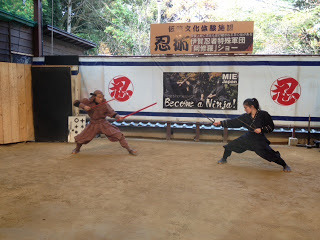 A mock battle between a samuari and a "kunoichi" (female version of a ninja) in Iga, Japan.
A mock battle between a samuari and a "kunoichi" (female version of a ninja) in Iga, Japan.
During at stay in Japan last year to visit my wife's family in the bustling, industrial city of Osaka, I took a trip to Iga, a town in Mie Prefecture that is known as one of the ancient birthplaces of the ninjas. It was a perfect place to do research for an upcoming book project, one set in medieval Japan when Ieyasu Tokugawa consolidated his rule of the country under the shoguns.
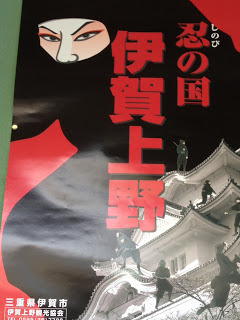 A poster for the town of Iga in Mie Prefecture, the "country of the ninjas".
A poster for the town of Iga in Mie Prefecture, the "country of the ninjas".
Ninjas played a special role in the feudal, war-torn period of medieval Japan between the 15th and 17th centuries. They were masters of covert warfare and espionage, possessing special skills that the formally trained samurai warriors lacked. The original ninja clans may have learned their techniques from Chinese mystic warriors according to Stephen Hayes famous book The Ninja and the Secret Fighting Art.
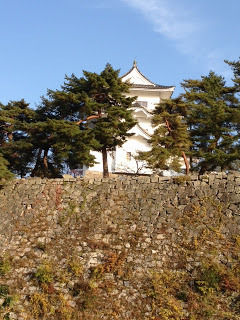 A castle in Iga, Japan.
A castle in Iga, Japan.
Ninjas (and their female counterparts, the Kunoichi) occupied a unique position in the social hierachy of feudal Japan: unlike the samurai and feudal lords, they were often recruited from the lower classes. They also organized their activities into specific roles: spy, scout, agitator or surprise attacker. In a society with rigid definition around an individual's role in society based on class, gender, etc., ninjas and kunoichi were mercenaries valued for their ability to transcend these social boundaries and play different roles. A ninja who came from humble origins might be valued for his ability to impersonate a noble warrior and penetrate enemy ranks. A kunoichi would be valued for ability to play different roles expertly, such as a Shinto shrine maiden or a palace geisha. She could wield tremendous power and influence in areas that were usually reserved for men in the danson jyohi (male dominated society) of traditional Japan.
Ninja clans would begin training their recruits from childhood in the mountains around Iga, with elaborate and painstaking lessons in balance and dexterity, such as making a young child stand on a tree branch all day long while remaining alert so he would not lose his balance.
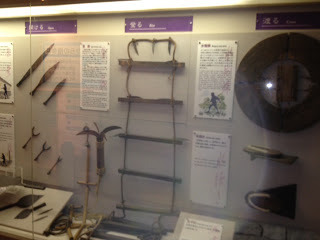
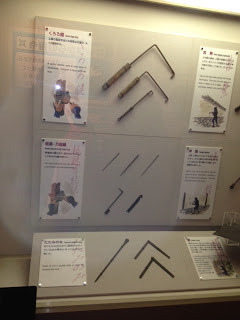 Ninja weapons on display in an Iga museum.There have been lots of books and films about the ninjas in popular culture. But I think there a few elements of the ninja society that haven't been explored and these will form the theme for one my upcoming novels. Post s on this blog form a sort of working diary of my research on this topic.
Ninja weapons on display in an Iga museum.There have been lots of books and films about the ninjas in popular culture. But I think there a few elements of the ninja society that haven't been explored and these will form the theme for one my upcoming novels. Post s on this blog form a sort of working diary of my research on this topic.
 A mock battle between a samuari and a "kunoichi" (female version of a ninja) in Iga, Japan.
A mock battle between a samuari and a "kunoichi" (female version of a ninja) in Iga, Japan.During at stay in Japan last year to visit my wife's family in the bustling, industrial city of Osaka, I took a trip to Iga, a town in Mie Prefecture that is known as one of the ancient birthplaces of the ninjas. It was a perfect place to do research for an upcoming book project, one set in medieval Japan when Ieyasu Tokugawa consolidated his rule of the country under the shoguns.
 A poster for the town of Iga in Mie Prefecture, the "country of the ninjas".
A poster for the town of Iga in Mie Prefecture, the "country of the ninjas".Ninjas played a special role in the feudal, war-torn period of medieval Japan between the 15th and 17th centuries. They were masters of covert warfare and espionage, possessing special skills that the formally trained samurai warriors lacked. The original ninja clans may have learned their techniques from Chinese mystic warriors according to Stephen Hayes famous book The Ninja and the Secret Fighting Art.
 A castle in Iga, Japan.
A castle in Iga, Japan.Ninjas (and their female counterparts, the Kunoichi) occupied a unique position in the social hierachy of feudal Japan: unlike the samurai and feudal lords, they were often recruited from the lower classes. They also organized their activities into specific roles: spy, scout, agitator or surprise attacker. In a society with rigid definition around an individual's role in society based on class, gender, etc., ninjas and kunoichi were mercenaries valued for their ability to transcend these social boundaries and play different roles. A ninja who came from humble origins might be valued for his ability to impersonate a noble warrior and penetrate enemy ranks. A kunoichi would be valued for ability to play different roles expertly, such as a Shinto shrine maiden or a palace geisha. She could wield tremendous power and influence in areas that were usually reserved for men in the danson jyohi (male dominated society) of traditional Japan.
Ninja clans would begin training their recruits from childhood in the mountains around Iga, with elaborate and painstaking lessons in balance and dexterity, such as making a young child stand on a tree branch all day long while remaining alert so he would not lose his balance.

 Ninja weapons on display in an Iga museum.There have been lots of books and films about the ninjas in popular culture. But I think there a few elements of the ninja society that haven't been explored and these will form the theme for one my upcoming novels. Post s on this blog form a sort of working diary of my research on this topic.
Ninja weapons on display in an Iga museum.There have been lots of books and films about the ninjas in popular culture. But I think there a few elements of the ninja society that haven't been explored and these will form the theme for one my upcoming novels. Post s on this blog form a sort of working diary of my research on this topic.
Published on April 28, 2013 08:34
No comments have been added yet.



